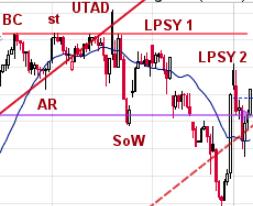Wyckoff Analysis in the Intraday Timeframe: Decoding Market Trends
Understanding market trends and interpreting price movements are pivotal aspects of successful trading. Richard D. Wyckoff, a pioneer in technical analysis, developed a methodology that focuses on the study of market trends and the interaction between supply and demand. This article delves into Wyckoff analysis in the intraday timeframe, shedding light on how traders can utilize this approach to gain valuable insights and make informed trading decisions.
Wyckoff Methodology Overview
Richard Wyckoff’s methodology is centered around the concept of cause and effect. According to Wyckoff, price movements are the result of supply and demand imbalances in the market. By analyzing the relationship between buying and selling pressure, traders can anticipate potential market movements and identify trading opportunities.
In the intraday timeframe, Wyckoff analysis can be applied to short-term price fluctuations and market dynamics. Traders can observe price actions, volume patterns, and market sentiment to assess the underlying supply and demand forces driving the market.
Key Principles of Wyckoff Analysis
1. Accumulation and Distribution: Wyckoff identified key phases in the market cycle, including accumulation (buying) and distribution (selling) zones. Traders can look for signs of accumulation or distribution to gauge the strength of market participants and potential price reversals.
2. Volume Confirmation: Volume plays a crucial role in Wyckoff analysis, serving as a key indicator of market activity and confirming price trends. High volume accompanied by price movements indicates strong buying or selling pressure, signaling the sustainability of a trend.
3. Support and Resistance Levels: Wyckoff analysis emphasizes the importance of identifying support and resistance levels within the intraday timeframe. These levels can act as barriers for price movements and help traders anticipate potential trend reversals or breakouts.
4. Trend Identification: By analyzing price actions and volume trends, traders can identify the prevailing market trend in the intraday timeframe. Wyckoff analysis enables traders to differentiate between trending and range-bound markets, allowing them to adjust their trading strategies accordingly.
Application in Trading Strategies
Traders can apply Wyckoff analysis in the intraday timeframe to develop effective trading strategies based on market trends and price dynamics. By integrating key principles such as accumulation, distribution, volume confirmation, and trend identification, traders can make informed decisions and enhance their trading performance.
For instance, traders can use Wyckoff analysis to identify entry and exit points in intraday trading, based on price patterns and volume signals. By combining technical analysis tools with Wyckoff principles, traders can improve their timing and accuracy in executing trades.
Conclusion
Wyckoff analysis provides traders with a systematic framework for understanding market trends and interpreting price movements in the intraday timeframe. By applying key principles such as accumulation, distribution, volume confirmation, and trend identification, traders can gain valuable insights into market dynamics and make informed trading decisions. Incorporating Wyckoff methodology into trading strategies can enhance profitability and improve trading outcomes in the fast-paced intraday market environment.
